
|
Sale 46
The Millennia Collection
| Lot |
Photo |
Description |
Realized |
Lot 475 |
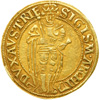 |
Austria. Goldgulden, ND. Fr-6. 3.25 grams. 22.81 mm. Archduke Sigismund, 1439-1496. Posthumous, minted after 1508. Hall mint. Obv. Standing Archduke, head breaking legend at top, holding sword and short scepter. Leg: SIGISM.ARCHI - DUX. AUSTRIE. Reverse Arms of Austria, Karten, Steirmark & Tyrol in angles of floriate cross. Leg: +MONETA.AUREA.COMITIS.TIROL. Very Scarce. NGC graded EF-45.
This coin is a departure from the earlier types in that a secular figure (Archduke Sigismund), replaces a religious figure (St John), on the coins. Perhaps an indication of the trend towards secularization in Europe at the time.
Estimated Value $1,500 - 2,000.
(*).
View details and enlarged photos
| Unsold |
Lot 476 |
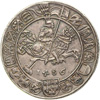 |
Austria. Guldiner, 1486 (Hall). Dav-8087; Schulten 4424; MT 64 var. 31.54 grams. Mintmaster: B. Beheim; Die maker: Wenzel Krondl. Archduke Sigismund, 1446-1490. Sigismund, crowned and armored, stands frontal holding scepter, helmet and lion-supported crest flanking; all within poly-lobed tressure. Reverse: Prince riding right, armed as a jousting knight, date below; around, border of 15 ducal shields, flanking larger shield of Austria bearing five eagles. Usual minor weakness seen at the Prince's feet, otherwise an unusually choice example of this issue, with fine details and quite clean fields. Handsome old toning. NGC graded AU-50.
Major silver deposits found in the Tirolean mines, and improved minting techniques, set the stage to produce the world's first large silver Talers, and here is an outstanding example of the first dated Taler ever produced. An important, histocial piece, and a must for all serious Taler collectors.
Estimated Value $10,000 - 12,500.
Illustrated in Money of The World, coin 90.
View details and enlarged photos
| Realized
$17,825 |
Lot 477 |
 |
Austria. Holy Roman Empire. Gold 7 Ducats, ND (after 1511) (Hall Mint). Of the highest Rarity! FR--. Cf.: Dav --; Egg. 15; Voglh. 3, all silver Guldiners. 24.18 grams. Maximilian I, 1490-1519. Laureate youthful bust of Maximilian right, draped and mantled, with shoulder-length hair; Latin titles around, across field, "ETA - TIS - 19 -." Reverse: Draped bust right of young Mary; Latin titles around, across field, "ETA - TIS - 20 -," 1479 below bust. Very slight doubling to portion of obverse inscription; with only a hint of doubling at parts of the portraits. Carefully handled and preserved over the years, with only a few trifling marks. Especially choice for issue in general. NGC graded MS-63.
Maximilian was able to consolidate the Habsburg holdings through marriage and outright purchase. He married the only daughter of the duke of Burgundy, Mary, in 1477, and thus obtained control of the Burgundian Netherlands. In 1490, he bought Tyrol and Further Austria from his cousin Sigismund. In 1493, the death of his father Friedrich III, gave Maximilian control of all the Habsburg lands. This consolidation led to the modern power of the Holy Roman Emperors. A most historic issue that also bridges the gap from medieval Europe to the Renaissance.
Maximilian likely had these issues struck as a gentle remembrance of his first wife, the late Mary of Burgundy, some time after the death of his second wife, Maria Bianca Sforza, perhaps around 1511. A silver medal (of perhaps 1479), commemorating the marriage, would have served as the prototype for these issues; cf. Lobbecke 404. Maximilian was 19 years old at the time of their marriage; Mary was 20.
Estimated Value $350,000 - 400,000.
Ex Gallereis des Monnaies & Spink, October 1973, realized 185,000 Sfr; Illustrated in Money of The World, coin 79.
View details and enlarged photos
| Realized
$632,500 |
Lot 478 |
 |
Austria. Ducat, 1555. Fr-42. 3.52 grams. Klagenfurt. Ferdinand I, 1521-1564. Obv. Standing figure of St. Ladislaus. Leg: MON.AVRE.FER-D-INAN.D.G.RO. Reverse Date above crowned shield. Leg: HVN.BO.REX.IN.HIS.ARCHID.CA.date. Lightly cleand. Lustrous. About Uncirculated.
Estimated Value $1,200 - 1,500.
(*).
View details and enlarged photos
| Realized
$1,438 |
Lot 479 |
 |
Austria. Taler, 1595 (Kuttenberg). Dav-8079. Rudolph II, 1576-1612. Bust right. Reverse: Eagle. Lovely blue and gold toning. An exceptional example, blessed by a charming portrait. NGC graded MS-61.
Kuttenberg, located in modern-day Czechoslovakia, was home to some important silver mines in late medieval times, a logical place to produce some of the finest Talers of the Holy Roman Empire. Note the legend naming Rudolph as king of Bohemia.
Estimated Value $600 - 800.
View details and enlarged photos
| Realized
$978 |
Lot 480 |
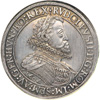 |
Austria. 2 Talers, 1604 (Hall). Dav-3004; KM-611.2; 57.2 grams. Rudoph II, 1576-1612. Obverse error in legend: RVDOLPHVS II : DG. Laureate bust right. Reverse: Crowned arms in Order chain. Considerable luster, well struck and nicely toned, with a fabulous portrait. Rare. NGC graded MS-63.
The eldest son of Emperor Maximilian II and the Infanta Maria of Spain, Rudolph became king of Hungary (1572-1608) and Bohemia (1575-1611) before assuming the robes of Holy Roman Emperor in 1576. He was an eccentric and learned man. His ability to rule was plagued by bouts of melancholy, and by occasional fits of insanity. Absorbed in culture, and surrounded by genius and talent, he sometimes forgot his principal reason for being, which was defense of the nation. His art collection later became a strategic target for the Swedish army during the Thirty Years War, caused in part by religious riots and revolts during his stewardship of Austria.
Estimated Value $2,000 - 2,500.
Ex Irving Goodman Collection.
View details and enlarged photos
| Realized
$3,105 |
Lot 481 |
 |
Austria. Taler, 1643-KB (Kremnitz). Dav-3198; KM-107. Ferdinand III. Laureate head right. Reverse: Crowned, double-headed eagle. Lustrous and as struck, on a marvelous flan of full size and good metal, the portrait clear, legends complete, lovely "old cabinet" lilac and blue tone. NGC graded MS-63.
Ferdinand III took the thrown at age 17 and ruled for 19 years until his death. He was married three times with the first two wives predeceasing him but he left numerous descendants.
Estimated Value $500 - 600.
Ex Irving Goodman Collection.
View details and enlarged photos
| Realized
$1,380 |
Lot 482 |
 |
Austria. 2 Ducats, 1645-M.I. (Breslau). Fr-223 (143); Henirek-173. 6.90 grams. Ferdinand III, 1625-1637-1657. Crowned bust right. Reverse: Crowned double-headed eagle; M - I, on either side (Mintmaster Michael Jan). Exceptionally choice, sharply and evenly struck on essentially a perfect flan. Lustrous and beautifully centered, with high rim beading. Extremely rare. The very image of its age, a masterpiece in gold! NGC graded MS-63.
Breslau (Polish Wroclaw) epitomized much of Central European history, in that "every time the wind changed directions" the city changed hands. Straddled on a major trade route, along the Oder River, running from the south of Europe to the Baltic Sea, Breslau remained the largest and most culturally dominant center in the region known as Silesia.
Estimated Value $6,000 - 7,000.
View details and enlarged photos
| Realized
$10,350 |
Lot 483 |
 |
Austria. Ducat, 1648. Fr-227; KM-1418. Prague mint. Mintmaster (mintmark), Jakob Wernhart Wolker, 1637-1649. 3.45 grams. 22.31 mm. Ferdinand III, 1637-1657. Obv. Laureate bust of Ferdinand right. Leg: FERDIN.III.DG.RO.IMPERA.S.A. Reverse Crowned double eagle, on breast, crowned Bohemian shield, mintmaster mark below. Leg: GER.HUN.BOH. - EMIAE.REX.1648. Razor sharp and fully lustrous. Very Rare. NGC graded MS-64.
This is an amazing coin in terms of its quality. The details are of a sharpness not to be normally found. "Ger" signifying Germany is added to the legend indicating that the Peace of Westphalia established Germany as sovereign states answerable to the Emperor.
Estimated Value $10,000 - 12,500.
(*).
View details and enlarged photos
| Realized
$18,400 |
Lot 484 |
 |
Austria. Taler, 1653 (Kremnitz). Dav-3198. Ferdinand III, 1637-1657. Laureate head right. Reverse: Crowned double eagle. Unusually bold strike for issue, and possessed of a charming portrait, aglow with 17th-century luster, and made beautiful by evenly distributed, premium silvery bluish gray toning. A delightful example! NGC graded MS-64.
Ferdinand inherited the Thirty Years War upon ascending the throne after the passing of his father, Ferdinand II.
Estimated Value $700 - 900.
Ex Irving Goodman Collection.
View details and enlarged photos
| Realized
$1,955 |
Lot 485 |
 |
Austria. 2 Talers, ND (Hall). Dav-3363. 57.4 grams. Archduke Ferdinand Karl, of Tyrol, 1632-1662 Bareheaded bust right. Reverse: Crowned eagle. A charming silver piece, beautifully toned in medium gray with hues of bluish lilac iridescence, sharply struck with crisp legends and a marvelously detailed, likelife portrait. As delightful as can be! NGC graded MS-64.
Ferdinand Karl was the nephew of Emperor Ferdinand II, and succeeded his father, Leopold,as ruler of the Tirol. His rule was inconsequential, but his coins were magnificent emblems of their age, the end of the Renaissance and the beginning of the Age of Reason. Notice the epaulette, the sun blowing wind (an ancient image, born in Greek Sicily).
Estimated Value $2,000 - 2,400.
Ex Irving Goodman Collection.
View details and enlarged photos
| Realized
$2,760 |
Lot 486 |
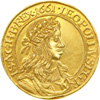 |
Austria. 5 Ducats, 1661 (Vienna). Fr- 262 (174); Henirek-85. 17.4 grams. Leopold I, 1657-1705. Laureate bust right. Reverse: Crowned double-headed eagle. A premium specimen, technically choice, fully Uncirculated with slightly prooflike fields heavy with luster, the flan broad and deeply impressed, creating a delightful portrait! High-level eye appeal, and extremely rare. NGC graded MS-63.
Leopold, second son of and successor to Ferdinand III, ascended to the Imperial throne during one of the most tumultuous periods in the Holy Roman Empire's history. His reign saw incessant warring with a resurgent Ottoman Turkey and a territorially aggressive France, and his era roughly corresponded to the rule of France's Louis XIV, yet he was overshadowed by Louis' charisma and aggression. Austria's wartime need for capital expenditures insured that silver coinages would be among the most prolific of the Hapsburgs. However the larger denomination gold issues remain rare to excessively rare, depending upon the individual issue. This splendid coin epitomizes its times.
Estimated Value $14,000 - 16,000.
Illustrated in Money of The World, coin 96.
View details and enlarged photos
| Realized
$16,100 |
Lot 487 |
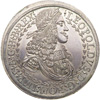 |
Austria. Double Taler, ND (c. 1680) (Hall). Dav-3247; KM-1191; Henirek-571. 57.26 grams. Leopold I, 1657-1705. Laureate, draped and cuirassed bust right, wearing the order of the Golden Fleece. Reverse: Crowned eagle, head left with wreath in beak, all within circular foliate border; inscription around. An especially fine example -- truly sharp, and free of the the usual striking problems. Minor obverse rim bruise; small planchet flaw on reverse. Appealing light to medium gray toning, very even, tending toward shades of pinkish gold, over abundant mint luster. Rare in this quality. NGC graded MS-65.
Leopold was probably a little behind the times in his antipathy toward Protestantism. In fact, his attempts at crushing Protestant revolts in Hungary led to the Turks marching against him. It was only through the wartime skill of the German Princes and John Sobieski of Poland that the Turks did not wipe out Vienna. We can only speculate how the future might have evolved had the Holy Roman Empire become a Turkish territory. Few silver coins of that era are so splendidly engraved and rendered as this coin.
Estimated Value $2,500 - 3,000.
View details and enlarged photos
| Realized
$4,600 |
Lot 488 |
 |
Austria. Taler, 1693-KB (Kremnitz). Dav-3263; Hus-1734; KM-214.6. Leopold I. Bust right, as Holy Roman Emperor, with classic jutting jaw, flowing locks and elegant garb. Reverse: Crowned, double-headed eagle with crest on breast. Considerable luster, brilliant benath elegant silvery blue toning, the strike bold, all producing exceptional eye appeal. NGC graded MS-64.
Estimated Value $500 - 600.
Ex Irving Goodman Collection.
View details and enlarged photos
| Realized
$1,783 |
Lot 489 |
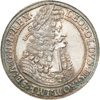 |
Austria. Taler, 1704 (Hall). Dav-1003. Leopold I, 1657-1705. Laureate, draped bust right, wearing the order of the Golden Fleece. Reverse: Crest within circular garter border; inscription around. A real museum-quality gem, boldly struck on a wonderful flan, broad and lustrous from the roller-dies impression, superbly toned in a palette of artist's iridescence. Note how Leopold's chin cotinued to protrude with age. NGC graded MS-65.
Estimated Value $1,000 - 1,200.
View details and enlarged photos
| Realized
$2,645 |
Lot 490 |
 |
Austria. Taler, 1721 (Hall). Dav-1053; KM-692. Charles VI, 1711-1740. Bust with long flowing hair right. Reverse: Crowned double-headed eagle. Beautiful rainbow toning. NGC graded MS-62.
Charles was another ineffectual ruler. He spent most of his time attempting to insure the succession of his daughters to the Habsburg crown. He succeeded in this goal, but failed at most other political matters. Note the intricate wig he is wearing. Imagine how uncomfortable such affectations must have been.
Estimated Value $500 - 700.
View details and enlarged photos
| Realized
$990 |
Lot 491 |
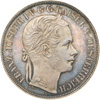 |
Austria. 2 Talers, 1857-A (Vienna). Dav-20; KM-2246.1. Franz Joseph, 1848-1916. For the completion of the South Austrian railways. Laureate head right. Reverse: Steam engine, paddle-wheel boat, and lighthouse, with flanking arabesques and shields at bottom. Sharply and fully struck. Beautiful iridescent toning. Has the appearance of a proof, with semi-frosted cameo portrait. The reverse a delightful "snapshot" of the most advanced technologies at the time. NGC graded MS-64 Prooflike.
Railroads are today taken for granted. In the mid-nineteenth century, the ability to travel quickly throughout a country was a measure of great technological advancement and pride. This particular Double Taler notes these accomplishments and is one of the most popular coins of the century.
Estimated Value $2,500 - 3,000.
View details and enlarged photos
| Realized
$4,255 |
Lot 492 |
 |
Austria. 25 Schilling, 1938. Fr-525; KM-2856. Eagle. Reverse St. Leopold holding model of Church. Mintage 1,360 struck. Extremely Rare date. NGC graded MS-63.
Estimated Value $15,000 - 20,000.
(*).
View details and enlarged photos
| Realized
$22,425 |
Lot 493 |
 |
Austria -- Batthyani. Taler, 1768. Dav-1183; Holzm-13; KM-6. Karl Joseph, 1764-1772. Vienna mint. Bust right. Reverse: Crowned and mantled arms. Only 300 pieces struck. Fully lustrous, reflective fields and lovely mottled toning, pastel pink and mauve, with some blue hues. NGC graded MS-63 Prooflike.
Karl Joseph was from an ancient and venerable Hungarian family, and was a loyal follower of the Emperor. After fifty years of service he was rewarded with the title of Prince of the Empire and was granted the mintage right. Since his territory was quite small, he only issued a small number of coins.
Estimated Value $1,000 - 1,300.
Ex Irving Goodman Collection.
View details and enlarged photos
| Realized
$2,990 |
Lot 494 |
 |
Austria -- Batthyani. Taler, 1788. Dav-1184; Holzm-17; Unger-3684; KM-8. Vienna mint. Ludwig, 1788-1806. Head right with I.N. Wirt. below. Reverse: Crowned, mantled and supported arms. Fully lustrous, reflective fields having lovely iridescent toning. NGC graded MS-64.
The Batthyanis were an old and well-connected princely family in western Hungary, with additional estates and holdings in Austria, Styria and Bohemia. In payment for favors or services rendered, the Hapsburg Empress Maria Theresa allowed them the privilege of coining, commencing under Karl Joseph in 1764. Although minting lasted barely two generations, the output was respectable if not huge, consisting primarily of silver Thalers and their fractions. The family's gold trade ducats nevertheless included both five- and ten-ducat denominations, the latter weighing in at a respectable 1.1-plus ounces.
Estimated Value $900 - 1,000.
Ex Irving Goodman Collection.
View details and enlarged photos
| Realized
$2,645 |
Lot 495 |
 |
Austria -- Burgau. Convention Taler, 1766 (Gunsburg). Dav-1148; KM-16. Maria Theresa. Crowned supported shield. Reverse: Date within wreath. A delightful representative of this scarce coinage, toned an even and pleasing silvery gray, with sharp details. NGC graded MS-63.
The Empress Maria Theresa was the only female to rule among all the members of the 650-year-long Habsburg dynasty that ended in 1914. Her capabilities and personal constitution made her one of the longest reigning empresses among her contemporaries.
Estimated Value $300 - 400.
Ex Irving Goodman Collection.
View details and enlarged photos
| Realized
$489 |
Lot 496 |
 |
Austria -- Dietrichstein. Taler, 1653. Dav-3374; Unger-3703; KM-9. Sigismund Ludwig von Weichselstatt, 1631-1664 (County Line of Pulsgau). Bust right with date under shoulder. Reverse: Crowned double eagle with "F III" on breast over small arms. Motto on band below. Graz mint. Boldly struck from roller dies with prooflike fields. Gorgeous iridescent toning with shades of russet and gold. Superb and very rare this nice. One of the most enchanting silver pieces in this large collection. NGC graded MS-66.
The counts of Dietrichstein were honored as the hereditary cup bearers for the Emperor. Their area of rule consisted of just one castle and the surrounding countryside (Pulsgau). One needs to appreciate how few of these coins were produced. This MS 66 example is undoudtably one of the finest known. Purchased obviously for its quality, but also for its splendid, greatly detailed portrait, among the least seen busts among thousands of types of European talers.
Estimated Value $3,000 - 4,000.
Ex Irving Goodman Collection.
View details and enlarged photos
| Realized
$5,520 |
Lot 497 |
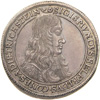 |
Austria -- Dietrichstein. Taler, 1664. Dav-3375; Holzm-27; Unger-3706; KM-12. Sigismund Helfried, 1664-1698. Bust right. Reverse: Flower, crowned arms in sprays. Graz mint. Most pleasing lilac gray toning, and super sharp in strike, producing a coin of especially fine eye appeal. Rare. NGC graded MS-63.
Estimated Value $1,250 - 1,500.
Ex Irving Goodman Collection.
View details and enlarged photos
| Realized
$3,220 |
Lot 498 |
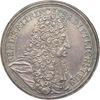 |
Austria -- Dietrichstein. Taler, 1695. Dav-3376; Unger-3708; Holzm-33; KM-20. Ferdinand Josef, 1655-1698 (Princely Line of Nikolsburg). Mintmaster, Matthias Mittermayr. Bust right. Reverse: Crowned arms in Order chain. Vienna mint. Lovely old toning with shades of blue and hints of russet. Rare. NGC graded MS-64.
Dietrichstein was divided into two branches, Pulsgau and Nikolsburg. All coins from this Principality are rare, but this is the only Taler from the Nikolsburg line. An almost impossible type to find, and what a wonderful specimen it is!
Estimated Value $1,250 - 1,500.
Ex Irving Goodman Collection.
View details and enlarged photos
| Realized
$2,415 |
Lot 499 |
 |
Austria -- Dietrichstein. Taler, 1695. Dav-3376; Holzm-33; KM-20. Ferdinand Josef of Nikolsburg, 1655-1698. Bust right. Reverse: Crowned arms in Order chain. Light scratches in obverse field and small natural rim flaw. Lustrous with lovely old lilac-gray and mauve toning. NGC graded MS-63.
Estimated Value $1,250 - 1,500.
Ex Irving Goodman Collection.
View details and enlarged photos
| Realized
$1,955 |
Lot 500 |
 |
Austria -- Eggenberg. Taler, 1630. Dav-3383; Holzm.S.19; Meyer-17; Unger-3720; KM-15. Johann Ulrich, 1623-1634. Bust in ruffed collar right. Reverse: Crowned arms in Order chain. Prague mint. Dramatic portrait wearing a large ruff. Beautiful old multi-colored gray toning. Rare. NGC graded AU-55.
A small princely state, Eggenberg is located near Graz, in Styria, and its castle serves today as a famed brewery and vacation spot. Ferdinand II gave the land to Johann Ulrich during the Thirty Years War as compensation for his lending money to the Empire.
Estimated Value $2,000 - 2,500.
Ex Irving Goodman Collection.
View details and enlarged photos
| Realized
$7,188 |
Lot 501 |
 |
Austria -- Khevenhuller-Metsch. Taler, 1761. Dav-1188; Holzm-41; KM-1. Johann Joseph, 1742-1776. Bust right. Reverse: Helmeted and supported arms. Very reflective surfaces and nicely toned in shades of grayish mauve. NGC graded MS-63.
The family was prominent old royalty of Carinthia (Karnten), who regained their power after the anti-reformation wars of the 17th century. They became counts in 1673, and were elevated to Princes in 1763. Apparently Johann Joseph (1742-1776) was the only member to exercise the coining privileges. Taler output was very small, while trade Ducats seemed to have been struck in some quantity.
Estimated Value $1,000 - 1,250.
Ex Irving Goodman Collection.
View details and enlarged photos
| Realized
$2,645 |
Lot 502 |
 |
Austria -- Lobkowitz. Taler, 1794. Dav-1190; Unger-3814; Holzm-58; KM-11. Franz Josef Maximilian, 1784-1816. Bust right with "VI" below. Reverse: Two shields crowned and mantled. Vienna mint. Mintmaster, Carl Johann Vinazer. Only 300 pieces struck. Brilliant prooflike fields with peripheral gold toning. An original and attractive example. NGC graded MS-61 Prooflike.
Lobkowitz is still a noble family today. In fact, there is a palace in Vienna that was owned by the Lobkowitz family until 1980. It is presently the theater museum of the Austrian National Library. Franz Josef Maximilian is best known as Beethoven's patron.
Estimated Value $1,000 - 1,250.
Ex Irving Goodman Collection.
View details and enlarged photos
| Realized
$3,105 |
Lot 503 |
 |
Austria -- Olmütz. 5 Ducats, 1678. Fr-76 (60); Lich-May-237; Dav-type 3484; KM-78. 17.35 grams. Karl II von Liechtenstein-Castelcorn, 1664-1695. Bust of Karl II in chasuble right. Reverse: Mitered and crowned arms, escutcheon at center, date within garniture. A splendid piece, sharply impressed on a broad full flan, now beautifully toned in reddish gold hues, with a remarkable portrait. Very rare. NGC graded MS-64.
Olmutz, or Olomouc in Czech, is located in the eastern part of the Czech Republic. Always an important ecclesiastical center, its bishops exerted tremendous influence throughout the Empire. Its silver coinage is quite extensive, but its gold coinage is rare. Multiple Ducats of the 17th century are especially hard to locate, and here is one of the finest extant examples.
Estimated Value $10,000 - 12,500.
Ex Otto Helbing, "Strother Collection," Lot 944, Munich, Feb. 14, 1921. Ex Irving Goodman Collection.
View details and enlarged photos
| Realized
$24,150 |
Lot 504 |
 |
Austria -- Olmütz. Taler, 1705. Dav-1209; KM-115. Karl III, Duke of Lorraine. Bust in dress right. Reverse: Crowned and supported arms. Deep iridescent blue-green over gray toning, with a wonderfully detailed portrait, on a broad flan, with legends extra sharp. NGC graded MS-63.
Located at the center of the large and fertile agricultural region of Hana in central Moravia, the town of Olmutz (Olomouc) is situated at the junction of the rivers Bystrice and Morava, and long prospered as an exporter of foodstuffs. Made a bishopric in the 11th century, it received a number of royal privileges allowing it to prosper in its various roles as a central marketplace, garrison town, government capital and university town. Unfortunately, being placed along an easily traversed crossroads made Olmutz a regular victim of invading hoards. Earlier incipient Moravian kingdoms disappeared at different intervals under the hooves of the Huns, the Avars and the migrating Magyars.
Estimated Value $500 - 600.
Ex Irving Goodman Collection.
View details and enlarged photos
| Realized
$960 |
Lot 505 |
 |
Austria -- Salzburg. Ducat, 1544. Fr-604; Prob-345. 3.50 grams. Ernst Von Bayern, 1540-1554. Obv. Date over shield and arms within circle. Leg: +ERNESTVS COF: IN ARIEP: SALZ: V.BA:DVX. Reverse Mitred, haloed Saint; saltbox in right, crozier in left and arms over feet. Leg: S.RVDBER - TVS. EPVS. Rim test cuts. Extremely Fine.
Estimated Value $1,250 - 1,500.
(*).
View details and enlarged photos
| Realized
$1,265 |
Lot 506 |
 |
Salzburg. Ducat, 1554. Fr-604; Prob-355. 3.52 grams. 22.50 mm. Ernst Von Bayern, 1540-1554. Obv. Date over shield and arms within circle. Leg: + ERNESTVS COF. IN ARIEPM. SALZ. V.BA.DVX Reverse Mitred, haloed Saint; saltbox in right, crozier in left and arms over feet. Leg: S. RVDBER - TVS. EPVS. A well struck example with considerable original mint luster. NGC graded MS-60.
Estimated Value $2,500 - 3,000.
(*).
View details and enlarged photos
| Unsold |
Lot 507 |
 |
Salzburg. Ducat, 1577. Fr-637; Prob-505. 3.47 grams. 21.76 mm. Johann Jakob Khuen Von Belasi, 1560-1586. Obv. Haloed, mitred Saint with crook; body covered with quartered shield and S - R (Sanctus Rudbertus) on either side. Leg: IO: IAC: D: G. ARL EPS: SAL. A.S. Reverse Double headed eagle. Leg: RVDOL: II: IMP: AVGVS:P:F:DE. Considerable original mint luster. NGC graded MS-61.
The title of the Holy Roman Emperor, Rudolph II, appears on the reverse here, but not on the earlier Salzburg Ducats. This is an indication of the growing power of the Empire, requiring such states as Salzburg to acknowledge its fealty.
Estimated Value $2,500 - 3,000.
(*).
View details and enlarged photos
| Unsold |
Lot 508 |
 |
Austria -- Salzburg. 10 Ducats, 1593. Fr-677 (569); Probzt-725. 43.33 grams. Wolf Dietrich von Raitenau, 1587-1612. St Rudbert holding city's arms. Reverse: Tower beset by the elements. Excellent strike. Very rare, large denomination. The sheer size of this piece made it difficult in the 16th century to strike it evenly and sharply. The soft gold generally took abuses poorly, and most known examples of this important coin are nowhere near as pleasing or as well made as this exceptional specimen. NGC graded AU-58.
The allegorical motif of the cross-crowned tower, or keep, beset by tempests, symbolized by the four winds all blowing at once, is a one-year type on all the gold coinage of the Archbishopric of Salzburg, and a two-year type on the silver coins. It is said to be a "beloved symbol of the Baroque."
Estimated Value $20,000 - 25,000.
Illustrated in Money of The World, coin 87.
View details and enlarged photos
| Realized
$28,750 |
Lot 509 |
 |
Salzburg. Ducat, 1678. Fr-813; Prob-1623; KM-194. 3.50 grams. 22.25 mm. Max Gandolph Graf Kuenburg, 1668-1687. Obv. Hatted arms, very; ornate. Leg: MAX: GAND:D:G:AR:EP:SAL:SE:AP:L. Reverse Seated Saint, holding orb and scepter. Leg: S: RVDBERTVS.EPS.SALISBVRG:,1678. NGC graded MS-61.
Clearly, coins of the latter part of the 17th century show improved minting techniques over their 16th century counterparts. This example, produced in 1678, is of a more modern appearance.
Estimated Value $1,400 - 1,700.
(*).
View details and enlarged photos
| Realized
$1,725 |
Lot 510 |
 |
Austria -- Salzburg. Taler, 1694. Dav-3510; KM-254. Johann Ernst von thun and Hohenstein. Madonna and child over hatted arms. Reverse: Saint behind arms. Lustrous with lovely iridescent toning. NGC graded MS-63.
Salzburg was the leading trade and religious center of the Austrian-Holy Roman Empire, and one of the most prolific and venerable of the "independent" coining entities. This a typical and handsome coin of the realm.
Estimated Value $300 - 400.
Ex Irving Goodman Collection.
View details and enlarged photos
| Realized
$552 |
Lot 511 |
 |
Salzburg. Ducat, 1705. Fr-833; Prob-1777; KM-257. 3.50 grams. 20.90 mm. Johann Ernst von Thun and Hohenstein, 1687-1709. Obv. Arms under a legates hat. Leg: .IO.ERNEST 9.D:G:ARCHIEP.SAL.S:A:L. Reverse Mitred, haloed, seated Saint with crook and salt box. Leg: S:RVDBERTVS.EPS.SALISBVRG.1705. NGC graded MS-61.
It should be appreciated how difficult it is to find these coins so choice, Collectors of the period, who would have saved these pieces, were almost non-existant.
Estimated Value $1,500 - 1,750.
(*).
View details and enlarged photos
| Unsold |
Lot 512 |
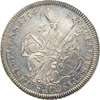 |
Austria -- Salzburg. Taler, 1754. Dav-1248; KM-380. Sigismund III, Count von Schrattenbach, 1753-1771. Madonna and child in square, arms on right. Reverse: Saint seated looking right with arms. Fully lustrous with reflective surfaces. NGC graded MS-63 Prooflike.
Salzburg dates back to Roman times, then known as Juvavum. Saint Rupert established his bishopric there around 700 AD. The site grew to become one of the most important Catholic bastions in Europe. Possibly the most bigoted of all Catholic areas, it expelled the Jews around 1500 and the Protestants in 1731.
Estimated Value $800 - 900.
Ex Irving Goodman Collection.
View details and enlarged photos
| Realized
$1,440 |
Lot 513 |
 |
Austria -- Schlick. Taler, ND (c.1517). Dav-8138; Doneb-3747. 28.91 grams. Counts Stephan, Burian, Heinrich, Hieronymus & Lorenz, 1505-1526. St. Joachim stands over quartered shield; S - I in field flanking. Reverse: Crowned rampant heraldic lion left. Lightly toned.Some slight double-striking to obverse, with usual weakness at centers. With considerable residual luster. Exceptional for these mostly poorly struck and preserved coins. Very Rare in this quality. NGC graded AU-55.
Schlick in modern Czechoslovakia (Bohemia) was controlled by the Slik family, which owned many important mines and produced enough silver to mint a large percentage of the first Talers. Originally known as Joachimsthalers, the name was shortened to Talers in the west, and Jefimoks in Russia.
Estimated Value $4,000 - 5,000.
Illustrated in Money of The World, coin 89.
View details and enlarged photos
| Realized
$4,830 |
Lot 514 |
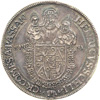 |
Austria -- Schlick. Taler, 1645. Dav-3408; KM-9. Heinrich IV, 1612-1650. Madonna and child with St. Anne with shield below. Reverse: Crowned, double-headed eagle. Toned. NGC graded AU-58.
This coin is from the very same Bohemian estate that helped to initiate and propagate the thaler "revolution" throughout Europe 125 years earlier. While the Schlicks were relative nobodies in the political sense, especially when compared to the power and prestige of their neighbor, the Elector of Saxony, their mines proved the richer and more enduring compared to anything in Saxony.
Estimated Value $1,000 - 1,250.
Ex Irving Goodman Collection.
View details and enlarged photos
| Realized
$1,783 |
Lot 515 |
 |
Austria -- Trautson. Taler, 1715. Dav-1200; Holzm-95; KM-31. Franz Eusebius, 1663-1728. Mintmasters, Matthias Mittermayer and J. Michael Hoffmann. Bust right. Reverse: Helmeted arms dividing date with MM below. Vienna mint. Lustrous with reflective fields and lovely iridescent toning. NGC graded MS-64.
Trautson produced a small number of Talers beginning with Paul Sixtus in 1617. The family was part of the Austrian nobility and had their ansecestral lands in Falkenstein. They were granted the mint right for their services to the Imperial court, but few coins were produced. Such coins served more to enhance the prestige of the noble families than to stimulate commerce.
Estimated Value $1,250 - 1,500.
Ex Irving Goodman Collection.
View details and enlarged photos
| Realized
$2,415 |
Lot 516 |
 |
Austria -- Zara. 9 Francs 20 Centimes (2 Ounce), 1813. Dav-48; KM-2. 59.1 grams In the center of a plain field an incused diamond with a crowned eagle in the center, flanked by ZARA and 1813. Reverse: Incused diamond with value. Three stamps on edge. Virtually as struck. Very rare this nice. NGC graded AU-58.
Zara was from Roman times an important trading port on the eastern Adriatic coast, in what is today's Croatia. In the Middle Ages the city was incorporated into the Republic of Venice's growing mercantile empire, lasting until 1797, when it was destroyed by Napoleon. The French then maintained control of the area until their reversals of 1813 brought back the Austrians as besiegers. The French defenders issued three necessity pieces of unusual values: 4 francs - 60 centimes; 9 francs - 20 centimes; and 18 francs - 40 centimes. All are rare.
Estimated Value $2,500 - 3,000.
Ex Irving Goodman Collection.
View details and enlarged photos
| Realized
$6,038 |
Lot 517 |
 |
Austrian Netherlands. Reichstaler (Ecu), 1714 (Namur). Dav-1277; Delm.-371; Hahn-222; KM-36. Maximilian II, Emanuel of Bavaria, 1679-1726, as Stadholder of Brabant. Draped and cuirassed bust right. Reverse: Crowned arms, escutcheons at center, Order of Golden Fleece around. Choice strike, with only minimal weakness on reverse, seen as some flat curls on the obverse. The obverse die showing patches of rust. Still, an exceptional example of this rarity, with fine silvery gray toning, and underlying golds at the edges. Very rare. NGC graded MS-63.
Maximilian Emanuel had been appointed governor general of the Netherlands in 1692 under the Spanish king, Charles II. Yet in 1713 the territory was given to the Holy Roman Empire under the Treaty of Utrecht. Theoretically, Maximilian should have been deposed. Yet for some years after 1713 the local authorities resisted imperial control, so Maximilian could remain in Namur and issue this rarity.
Estimated Value $15,000 - 20,000.
View details and enlarged photos
| Realized
$28,750 |
Lot 518 |
 |
Austrian Netherlands. Ducatone, 1749 (Antwerp). Dav-1280; Cr-12. Maria Theresa. Bust right. Reverse: Crowned arms in sprays. Fully lustrous with lovely toning and attractive mature portrait. NGC graded MS-63.
The Peace of Utrecht, which resulted in Imperial control of the Netherlands, in actuality was a series of treaties, the overall effect of which was to put an end to the French expansionism which had been plaguing Europe since the Thirty Years War in the previous century. One codicil required Louis XIV to recognize the English succession established by the House of Hanover. Another, with Spain, allowed that Britain would have sole right to the slave trade in Spanish America. One of the last treaties comprising the Peace, the Treaty of Baden (1714), confirmed Austria's ownership of the former Spanish Netherlands.
Estimated Value $800 - 900.
Ex Irving Goodman Collection; Illustrated in Money of The World, coin 111.
View details and enlarged photos
| Realized
$2,070 |
|
|